Papers by Domenico Lo Vetro
The role of human impacts and Holocene climate change in the

The latest research carried out in Grotta del Romito, a Palaeolithic site located in northern Cal... more The latest research carried out in Grotta del Romito, a Palaeolithic site located in northern Calabria, has brought to light a new Palaeolithic burial (Romito 9). The complexity of this archaeological evidence, also affected by a disturbance to the burial pit that altered the deposition’s context ab antiquo, has required a suitable strategy of excavation and documentation for the funerary context in order to read the taphonomic and post-depositional processes. The creation of a visual model representing the funerary evidence in a CAD environment has led to the virtual reproduction of the original archaeological context. This model, based on the processing of a very detailed graphic and photogrammetric documentation and linked to a database, provided an effective support to the interpretations and has allowed us to better investigate the deposition context and the subsequent events connected to the breach of the burial

Recent improvements in the analysis of ancient biomolecules from human remains and associated den... more Recent improvements in the analysis of ancient biomolecules from human remains and associated dental calculus have provided new insights into the prehistoric diet and past genetic diversity of our species. Here we present a “multi-omics” study, integrating genomic and proteomic analyses of two post-Last Glacial Maximum (LGM) individuals from San Teodoro cave (Italy), to reconstruct their lifestyle and the post-LGM resettlement of Europe. Our analyses show genetic homogeneity in Sicily during the Palaeolithic, representing a hitherto unknown Italian genetic lineage within the previously identified “Villabruna cluster”. We argue that this lineage took refuge in Italy during the LGM, followed by a subsequent spread to central-western Europe. Multi-omics analysis of dental calculus showed a diet rich of animal proteins which is also reflected on the oral microbiome composition. Our results demonstrate the power of using a multi-omics approach in the study of prehistoric human populations.
Gli Autori presentano i recenti approcci sviluppati per gestire i dati di scavo di Grotta del Rom... more Gli Autori presentano i recenti approcci sviluppati per gestire i dati di scavo di Grotta del Romito (Cosenza) al fine di indagare gli spazi domestici e rituali relativi all’Epigravettiano. Dopo aver introdotto il contesto stratigrafico e gli aspetti rituali e funerari si propongono alcune applicazioni GIS volte all’analisi integrata dei dati in ambiente 3D
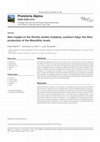
Romito shelter (Papasidero, Cosenza), set forward the cave of the same name, has been explored in... more Romito shelter (Papasidero, Cosenza), set forward the cave of the same name, has been explored in the 1960s by P. Graziosi. During his archaeological research, Graziosi opened a large trench parallel to the rocky wall, between the two well-known engraved boulders below the shelter. Graziosi brought to light a stratigraphic sequence containing several phases related to the Upper Paleolithic and the Neolithic. During the recent archaeological research carried out by the University of Florence, new excavations in the shelter were undertaken. The new excavations, performed close to the 1960s trench, revealed a pre-Neolithic sequence that testifies the human presence at Romito also during the Early Holocene. The stratigraphic sequence contains some Mesolithic paleosurfaces overlaying an Upper Paleolithic deposit. Mesolithic stone assemblages are placed within the context of the Sauveterrian-like armature complex of the low Tyrrhenian region.
During the recent excavations carried out by the Soprintendenza per i Beni Archeologici della Lom... more During the recent excavations carried out by the Soprintendenza per i Beni Archeologici della Lombardia close to the famous engraved boulders of Cemmo (Capo di Ponte, Brescia), an archaeological deposit was unearthed. The cultural sequence spans from the Early Mesolithic to the Copper Age. Among the lithic materials a Sauveterrian production has been identified. Mesolithic artefacts were found not only in primary deposition layers but also in other disturbed stratigraphic units containing intrusive Neo-Eneolithic artefacts.
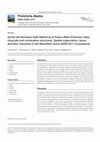
This paper presents the results of the study of the Mesolithic structures recovered during the 20... more This paper presents the results of the study of the Mesolithic structures recovered during the 20082011 field seasons. These include a combustion structure and several small post-holes in SU 582, a pit (SU 638) and a hearth (SUs 641-652) with adjacent charcoal-rich area (SU 657). The structures differ in morphology and content, although all of them yielded animal bone remains, malacofauna and tortoise shells. However, the quantity of bone remains and the ratio among species as well as the fragmentation of the specimens are considerably variable. Such variables characterize the structures evidencing their different functions. Considering as a whole the remains it contained (including a wolf hemi-mandible and posterior distal limb of a badger), the pit SU 638 has been interpreted as a “ritual pit” or, in any case, a pit used in propitiatory rituals. Among the lithic industry any selection of particular tools occours in the structures. The lithic assemblage, is referable to the Undiffe...
Two engraved bone points from Grotta del Romito (Graziosi excavations)

The analysis of geological patterns has become a focus of research in European Palaeolithic archa... more The analysis of geological patterns has become a focus of research in European Palaeolithic archaeology in order to identify strategies in raw-material procurement and to interpret past technical behaviour. The reconstruction of past geological landscapes enables the correlation of archaeological assemblages with raw-material provenance and large-scale transport patterns. The evidence for procurement strategies and the patterns of raw-material exploitation and transport have been used to assess mobility and cognitive abilities among Palaeolithic groups, revealing differing strategies between Middle and Upper Palaeolithic hunter gatherers. While Neanderthals seem to have organised their technology in a local or semi-local territory, modern humans have shown a more intense exploitation of distant sources. This scenario has been challenged over the last few years. Several studies have highlighted more complex environmental exploitation by Neanderthals through the catchment of distant lithic resources. The universities of Florence and Siena are engaged in a long-term project of geological survey that aims to identify lithic sources used during the Palaeolithic. Geological research has been carried out in parallel with technological analysis of archaeological lithic assemblages from the Mousterian layers of Grotta del Cavallo (Apulia, south-east Italy) and the Upper Palaeolithic layers of Grotta del Romito (Campania, south-west Italy). The project aims to answer specific questions regarding raw-material procurement: is it possible to predict human behaviour based on the distance between the settlement and the raw-material source? How did raw materials influence the variability of lithic assemblages? And, with regard to this latter question, which strategies were applied by hunter-gatherers regarding the use of the landscape and the available resources found within it? The integrated analysis of archaeological finds and ancient geological landscapes enables us to develop a complex scenario in which the rigid definition of the knapping concept and the economic strategies (e.g. curated and expedient behaviour) seems to be more strictly related to cultural constraints (shared knowledge, technical innovations and social and economic organisation) than to geophysical ones. We present here the methodology of geo-archaeological surveys and the preliminary results obtained for production sequences and procurement strategies at Grotta del Cavallo during the Middle Palaeolithic. At Grotta del Cavallo it could be evidenced that the human groups had great high mobility, which exceeded 50 km. Differences in techno-economy throughout the stratigraphical sequence of this site suggest that human strategies were influenced by several factors, including site use, demographic patterns and technical tradition, which generated various methods of adaptation to the available resources. The future implementation of this line of research, the integration of subsistence strategies and climate change analyses with that of stone tool assemblages and mobility, will make it possible to understand human behaviour and to explain the considerable variability of the archaeological record
1 Sezione di Bioarcheologia, Museo Nazionale Preistorico Etnografico “L. Pigorini”, Museo delle C... more 1 Sezione di Bioarcheologia, Museo Nazionale Preistorico Etnografico “L. Pigorini”, Museo delle Civiltà, Piazza G. Marconi 14, 00144 Roma, Italy 2 Dipartimento di Storia, Archeologia, Geografia, Arte e Spettacolo, Università degli Studi di Firenze, Via S. Egidio 21, 50122 Firenze, Italy 3 CeDaD (Centro di Datazione e Diagnostica), Dipartimento di Ingegneria e Innovazione, Università del Salento, Via per Monteroni 7, 73100 Lecce, Italy 4 Soprintendenza Archeologica, Belle arti e Paesaggio della Liguria, Via Balbi 10, 16126 Genova, Italy

The ‘Hidden Foods’ project is a new research programme aimed at reconstructing the importance of ... more The ‘Hidden Foods’ project is a new research programme aimed at reconstructing the importance of plant foods in prehistoric forager subsistence in Southern Europe, with a particular focus on Italy and the Balkans. The role of plant foods in pre-agrarian societies remains one of the major issues of world prehistory. Popular narratives still envisage ancient foragers as primarily ‘meat-eaters’, mainly as a consequence of the poor preservation of plant remains in early prehistoric contexts, and due to the employment of methods particularly focused on the contribution of animal protein to human diet (e.g. isotope analysis) (e.g. Bocherens 2009; Jones 2009; Richards 2009). Recently, new methods applied to archaeological evidence have provided a different understanding of hunter-gatherer dietary preference and interaction with the environment. Harvesting and processing might not have been the sole prerogative of agricultural societies, and plant foods seem to have played an important role...
Quaternary International, 2018
Quaternary Science Reviews, 2018
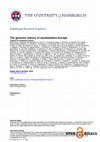
Farming was first introduced to southeastern Europe in the mid-7thmillennium BCE – brought by mig... more Farming was first introduced to southeastern Europe in the mid-7thmillennium BCE – brought by migrants from Anatolia who settled in the region before spreading throughout Europe. To clarify the dynamics of the interaction between the first farmers and indigenous hunter-gatherers where they first met, we analyze genome-wide ancient DNA data from 223 individuals who lived in southeastern Europe and surrounding regions between 12,000 and 500 BCE. We document previously uncharacterized genetic structure, showing a West-East cline of ancestry in hunter-gatherers, and show that some Aegean farmers had ancestry from a different lineage than the northwestern Anatolian lineage that formed the overwhelming ancestry of other European farmers. We show that the first farmers of northern and western Europe passed through southeastern Europe with limited admixture with local hunter-gatherers, but that some groups mixed extensively, with relatively sex-balanced admixture compared to the male-biased...

Quaternary International, 2016
Abstract Drawing upon the already well-known archaeological record and on recent data, we present... more Abstract Drawing upon the already well-known archaeological record and on recent data, we present a general overview of Mesolithic stone production in Central–Southern Italy and its main islands, Sicily and Sardinia. In the Early Mesolithic (10th–9th mill. uncal. BP ca.), the lithic industries of this wide area reveal the presence of different facies , each with its own peculiar techno-typological features; an articulate picture most likely originating from differentiations in lithic production already in existence at the end of the Epigravettian in both the central–southern regions of the peninsula and in Sicily. On the basis of the available chronological and stratigraphical record from several Mesolithic sites, these lithic facies at least appear to be partly contemporary. Two of them, a Sauveterrian-like aspect and the Undifferentiated Epipalaeolithic, spread more widely, involving both the peninsular region and the main islands. Regarding the Sauveterrian, both the variability and originality of the southern complexes seem to be in relation to the progressive distance from the northern areas. In Southern Apulia, we see the appearance of the Epiromanellian, coeval to the spread of Sauveterrian. In Sicily the situation is more intricate. During the Early Holocene an Epigravettian-tradition microlithic facies with unilateral backed tools and geometrics is attested on the island, spreading together with peculiar Sauveterrian-like industries and the Undifferentiated Epipalaeolithic. In Corsica–Sardinia, only the Undifferentiated facies is documented. The emergence of some industries with trapezes during the first half of 9th mill. cal. BP in Central–Southern Italy and Sicily and, later, in Tuscany attest the formation of Castelnovian-like aspects which closed the local Mesolithic cycle.
ABSTRACT Le recenti indagini archeologiche a Grotta d’Oriente1 hanno restituito numerosi manufatt... more ABSTRACT Le recenti indagini archeologiche a Grotta d’Oriente1 hanno restituito numerosi manufatti in materia dura animale riferibili a fasi distinte dell’occupazione preistorica (Martini, Lo Vetro, Colonese et alii, in questo volume). Questi reperti sono ricavati in particolare da conchiglie di molluschi marini, utilizzate come oggetti ornamentali (per lo più pendenti). Oltre agli ornamenti su conchiglia sono stati rinvenuti una decina di manufatti in osso e palco di cervide.
Méditerranée, 2009
Méditerranée 112 (2009) Géoarchéologie de la péninsule italienne .
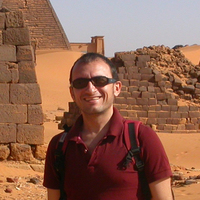




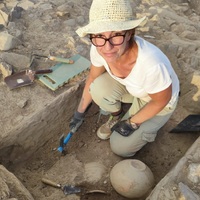




Uploads
Papers by Domenico Lo Vetro